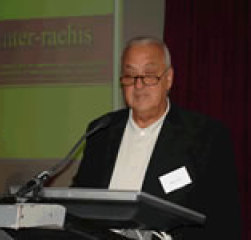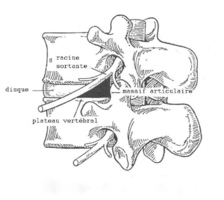
CERVICAL PERCUTANEOUS LASER DISC DECOMPRESSION
Eric GOZLAN(Paris), Valérie Lavignolle-Aurillac(Bordeaux)
IITS, Albi- juin 2007
STUDY DESIGN:
A prospective study concerning 57 cases with cervical disc herniations was evaluated 3 and 12 months after PLDD.
OBJECTIVES:
To describe the technique and to evaluate the efficacy and safety of the Holmium YAG laser (LIS), in a population suffering from a radiculopathy secondary to a soft cervical herniation.
This study excluded sequestered fragments and important degenerative changes.
SUMMARY OF BACKGROUND DATA:
PLDD was first initiated by CHOY and ASCHER in 1986 using a Nd:YAG laser at lumbar level.
In Europe, the first cervical level case was performed by J.HELLINGER in 1991.
In 1993, W.SIEBERT published a very large study in SPINE establishing the codification of the technique at the different levels of the spine. He concluded that HO:YAG laser is safer and more efficient, giving its best results at the cervical level.
RESULTS:
At 3 months, post-operatively we noted that:
- The neurological signs had totally disappeared.
- The average of the radicular pain was reduced by 82% on the AVS and the cervical pain by 69%. Also, the incapacity questionnaire, evaluated on 30 cases, showed a decrease of the average by 76%.
- 87% of the patients considered the result as a success.
At 12 months, the rate of success, evaluated on 27 cases, was maintained at 89%.
The statistical analysis using the Student test showed that the patients operated with this technique had significantly improved at 3 and 12 months post-operatively.
COMPARISON WITH OUR FIRST SERIES OF 29 CASES:
This new study, including 29 cases already evaluated in 2004 showed a clear improvement of the results, from 72% to 87%.
The comparison between the 2 series showed that the last 28 cases were a full success without any complications.
The main reason is due to a better patient selection. The selection criteria must associate radio- clinical correlation with evidence of a soft herniation and without important degenerative changes.
CONCLUSION:
The results of this second controlled study remain encouraging.
The statistical analysis showed a significant improvement at 3 and 12 months post-operatively.
This technique seems to be an interesting alternative to open surgery, being less invasive.
A better selection of patients has shown a clear increase of the success rate. However, the operator must be well trained on PLDD techniques.
The last generation of HO:YAG laser has made significant progress with regards to security.
The pain provocation during discography seems to have a prognostic value related to the good results.

